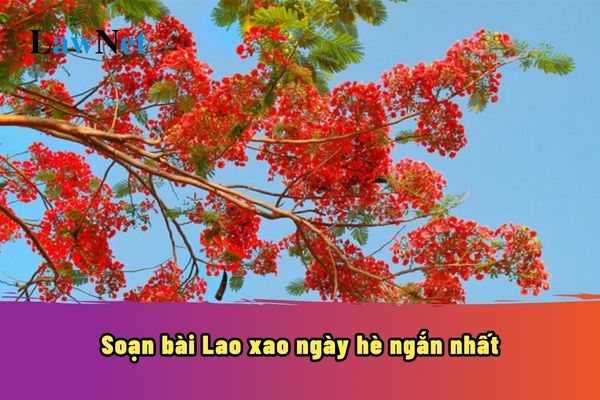What are the guidelines for preparing the shortest lesson "Lao xao ngày hè"? What are the requirements for Excellent level in the assessment of professional standards for teachers in Vietnam?
What are the guidelines for preparing the shortest lesson "Lao xao ngày hè"?
"Lao xao ngày hè" is a distinctive paragraph, showcasing the author's observational and descriptive talent, while conveying deep feelings about the homeland and the beautiful values of life.
6th-grade students can refer to the following sample lesson "Lao xao ngày hè":
|
Sample lesson "Lao xao ngày hè"
[1] Main Content of the Article:
The paragraph describes a vivid painting of rural life in the summer, focusing on the world of birds and their relationships with humans. The author records everyday activities, the distinctive sounds of summer, from birdsong, insect calls, to the barking of dogs and the sound of wind flutes. Through this, a realistic and lively depiction of the peaceful countryside, close to nature, is depicted. The main content can be summarized as follows:
The summer nature scene: The vibrancy of trees, flowers, the bustling life of insects.
The world of birds: Characteristics, behaviors, relationships among bird species, and their interactions with humans.
Human life: Daily activities, children's games, family meals under the porch, and sleeping outdoors.
Love and attachment to homeland: The author's affection for the homeland, beautiful memories of childhood.
[2] Meaning of the Article:
The paragraph reflects the author's keen observation and deep love for nature and rural life. Through realistic and lively images, the author conveys the following meanings:
Harmony between man and nature: Human life is closely linked with nature, integrating into the rhythm of nature.
The beauty of simple life: Simple, familiar things in daily life also contain their own beauty.
The value of childhood memories: Memories of summer, of homeland will forever be a precious luggage for everyone throughout life.
Emphasis on righteous living: Through the image of the drongo punishing the wicked (hawk, crow), the author expresses faith in justice and righteousness.
[3] Literary Devices of the Article:
The paragraph uses a variety of figures of speech, contributing to the vividness and imagery of the work:
Personification: Attributing human actions and emotions to animals (“Yellow bee, vespid, honeybee fighting”, “Gentle butterfly leaves the noisy place”, “Swallow freely flaps in the blue cloud ‘chick chick’”, “The rooster stands bewildered”, “Two Muscovy ducks ignore”), making the animal world close and lively.
Comparison: Using comparative images to describe objects and events concretely and vividly (“Plump dragon claw flowers smell like ripe jackfruit”, “The hawk darts like an arrow down”, “the kite spins in the Sqock field like a cut wire kite”), helping readers to easily visualize and feel.
Metaphor: “A black arrow, bearing a fish tail shape” refers to the drongo.
Enumeration: Enumerating bird species, summer sounds, human activities, creating an overall picture of rural life.
Repetition: “tu hú”, “drongo”, “bip bip”, “chick chick”... creating rhythm and emphasizing the characteristics of the subject.
Descriptive of nature reflecting emotions: Describing natural scenery to express the author’s emotions and feelings.
[4] Artistic Value:
The paragraph has high artistic value due to:
Language: Simple, pure, close to daily speech but still rich in images and expression.
Imagery: Vivid, realistic, clearly depicts the painting of rural life in the summer.
Tone: Gentle, lyrical, expressing deep affection and attachment to the homeland.
Structure: Coherent, clear, from describing natural scenery to the animal world and human life.
|
*Note: Information is for reference only./.

What are the guidelines for preparing the shortest lesson "Lao xao ngày hè"? What are the requirements for Excellent level in the assessment of professional standards for teachers in Vietnam? Image from the Internet)
What are the standards regarding the quality of Literature teachers in Vietnam?
Under Article 4 of the Regulations on Professional Standards for Teachers of General Education Institutions issued with Circular 20/2018/TT-BGDDT, 6th-grade Literature teachers must have the following qualities:
Standard 1. Quality
Comply with regulations and practice teacher’s ethics; share experience, support colleagues in practice of ethics and making of virtues
1. Criterion 1. Ethics
- Qualified: The teacher complies with regulations on ethics
- Good: The teacher has the spirit of self-study, self-training and attempts to improve moral qualities;
- Excellent: The teacher is a role model in terms of ethics, shares experience, support colleagues in practice of ethics
2. Criterion 2. Virtue
- Qualified: The teacher has manner and method of working in conformity with works;
- Good: The teacher has awareness of self-training to create an exemplary virtue; great influence on students;
- Excellent: The teacher is a role model in terms of virtues, has great influence and support colleagues in making of virtues.
What are the requirements for Excellent level in the assessment of professional standards for teachers in Vietnam?
Under Clause 6, Article 3 of the Regulations on Professional Standards for Teachers of General Education Institutions issued with Circular 20/2018/TT-BGDDT, the level of qualification means the level that a teacher has reached in development of quality and capacity of each criterion.
There are three levels in ascending order: qualified, good, excellent. The higher level includes the requirements of the adjacent lower level.
- Qualified: The teacher has the quality and capacity to perform assigned tasks in teaching and education for students according to regulations;
- Good: the teacher has the quality and capacity for self-study, self-practice, innovation in performance of assigned tasks;
- Excellent: the teacher has the positive influence on the students, colleagues, students' parents or guardians in formulation of the educational objectives of general education institutions and the development of local education.


